Victoria Sponge Cake
This Victoria Sponge Cake is the perfect recipe whether you like your cakes on the dry side or prefer them rich and moist. If you want it moist, soak it with juicy fruit, liqueurs, buttercream, or simple syrup with your favorite flavorings added. Not only is it delicious but it’s also beautiful, making it ideal for special occasions.
There is some confusion about the difference between a sponge cake and a pound cake. In Africa, pound cake is often called sponge cake. This is not a pound cake! Not that it’s better, just different. But I love them both! Take a look at my pound cake recipes, and you’ll find no less than seven mouthwatering cakes to choose from.
I would never admit to eating Twinkies, so this is just between you and me, agreed? Besides, homemade sponge cake with buttercream is so much better than those little packages with all the added chemicals.
|
Contents… Recipe Ingredients |
What Is Sponge Cake?
Sponge cakes are mostly eggs with a little sugar and flour. Because of this, they are light, airy, firm, and absorbent (like a sponge 😁), making them ideal for filling with homemade whipped cream, buttercream, and fruit sauces.
Because it’s so light, you don’t have to worry about the filling squishing out from the weight of the cake. That is something a pound cake can’t do for you (ask me how I know). And it’s incredibly mouthwatering in a Victoria sponge cake sandwich or strawberry shortcake.
Recipe Ingredients
This super-easy recipe takes simple shortcuts to make a light and fluffy sponge cake faster and without worries. After trying out several recipes, this is the one that I like the best, and it’s the easiest. It’s not your typical sponge cake because I couldn’t resist “Immafying” it.
Cake Batter
- Granulated sugar – Sweeten up your life with this versatile sweetener. If you want a sugar-free sponge cake, you can use a ½ cup of stevia and erythritol granules to replace the cup of granulated sugar.
- All-purpose flour – This basic pantry staple gives bulk to baked goods and thickens sauces and stews. If you need a gluten-free version, a good all-purpose gluten-free flour that does NOT have xantham gum should work. It has its own party with the eggs and messes up the texture, and experience has taught me that plain rice flour doesn’t work either.
- Unsalted butter – Creamy fat that gives rich moistness to baked goods. Sorry guys, you can use margarine if you want, but it won’t taste the same. Butter goes in both the cake and the buttercream.
- Eggs – The star of this sponge cake recipe acts as a leavening agent and binder, giving soft fluffiness, height, and strength.
- Baking powder – Not all sponge cake recipes include a leavening agent. However, I like to add it for good measure, especially since I’m not patient enough to beat the eggs for 20 minutes.
- Vanilla extract – There’s something about vanilla extract that adds a subtle creaminess and flavor that makes cakes even more delicious. With the price of real vanilla extract, it’s so much cheaper and better-tasting to make your own.
- Milk – While milk is in the cake, too, it is an essential ingredient in a good buttercream filling. You can use it to adjust the texture of frosting, too. Dairy free? Coconut milk will work.
Cake Filling (and Topping)
- Powdered sugar – This sweetener has a finer texture, so you have a smoother texture in frostings and cream fillings than you would if you used granulated sugar. A little secret: I grind granulated sugar in my blender with just a tad of cornstarch for a cheaper powdered sugar.
PRO TIP: To bring the eggs to room temperature quickly, simply submerge the eggs in a small or medium bowl filled with warm water for about 5-10 minutes.
How to Make Victoria Sponge Cake
The Cake
- Accurately measure ingredients – Weigh the sugar, flour, and softened butter. (Photos 1-4)
- Beat the eggs – Put eggs in a large mixing bowl and beat them. (Photo 5 & 6)
- Add the sugar, flour, and softened butter and mix thoroughly. (Photo 7 & 8)
- Add the rest of the ingredients – Add the baking powder, salt, vanilla extract, and milk.
- Thoroughly mix ingredients – using a handheld mixer or a stand mixer works just as well. Stir well until everything is fully combined. Scrape down the sides of the mixing bowl. (Photo 9)
- Pour the batter – pour batter evenly into greased cake pans; you can use a food scale to measure accuracy. Tap pans on the work surface to eliminate any large air bubbles. (Photos 10 & 11)
- Bake at 325℉/107℃ until a tester inserted into the center comes out clean, about 22-25 minutes or until golden and the cake springs back when pressed. Transfer to a wire rack to cool. (Photo 12)
Buttercream Filling
- Get your ingredients together – Add butter, powdered sugar, milk, and vanilla extract into a large bowl. (Photo 13)
- Cream the filling – Using a handheld mixer, mix until smooth and fluffy. Add more powdered sugar if the mixture is too light or more milk if it’s too dry to reach desired frosting consistency.
Assemble the Cake
- Organize the process – Place one cake on a cake stand or plate, then use a spatula to evenly spread strawberry or raspberry jam on the surface of the cake. Pipe or spread buttercream filling on the cake. (Photos 14-16)
- Top with the other cake and press lightly. (Photo 17 & 18)
- Finishing touches – Sprinkle powdered sugar over the cake, then decorate with strawberries, raspberries, or berries of your choice, if desired. (Photos 19 & 20)
- Enjoy! Slice and serve or refrigerate until ready to serve.
Recipe Variations
- Flavor Explosion – Add a teaspoon of your favorite extract, raspberry, almond, lemon, or a mix of two or three (blueberry lemon sounds good).
- Switch out the Fillings – Use your favorite pudding and fruit for a different style of cake. Or top it with a rich ganache for an extra special touch.
Tips and Tricks
- To get a fluffier cake, bring the eggs to room temperature before starting.
- If you want a British tea taste, then try soaking it with a strong Earl Gray tea.
- Fully preheat oven!
- Not the right pan? Split the batter between smaller pans. Keep an eye on it because it will bake faster.
- Make sure your mixing bowl is spotless, with no oil residue to hinder the eggs fluffing.
- For a chocolate sponge cake, you can replace some of the flour with cocoa powder. For example, you can sift together 2 ounces cocoa powder and 6 ounces of flour and continue with the instructions.
- To get the right consistency, pause, lift the beater and make a figure 8 using the batter dripping from the beater. Count to 10, and if you can still see the design in the batter, it’s ready. If it sinks into the batter before you make it to 10, beat it some more and try it again.
How to Keep Sponge Cake From Deflating
- Make sure the eggs are at room temperature and beat the heck out of them.
- Don’t use an electric mixer to fold the egg whites into the flour; use a wooden spoon or spatula to fold them in gently, and don’t overbeat.
- Don’t grease the pan. That way, the cake will stick slightly to it, and the pan will help hold it up.
- Make sure your oven is fully preheated, so the cake raises and cooks fast enough. An oven that isn’t hot enough is a major culprit for falling cakes.
- Resist the temptation to open the oven door during the first 20-30 minutes. The sudden temperature when the oven door is opened before the egg has cooked enough to hold the cake’s shape will cause it to fall.
- Bake it long enough for it to cook thoroughly.
- The ratio of flour and eggs to the sugar, butter, and baking soda has to be right to provide a solid structure to stay fluffy. (Gluten-free sponge cakes are not impossible to make, just harder.)
- Try turning the pan upside down while cooling the cake. Gravity can help you out and keep it from falling before it cools. After it’s cool, it should be more stable.
Storage and Serving
Yes, you can make this drool-worthy cake ahead of time. As long as you allow it to cool completely, it stores well at room temperature in an airtight container.
Alternatively, you can keep it in the fridge for a week or freeze it for up to 3 months.
FAQs
This cake is meant to be on the dry side, making it perfect for soaking up flavorful syrups, fillings, and liquor. I’m thinking of my German friend’s Black Forest cake, a chocolate sponge cake soaked in kirschwasser.
You can. My recipe uses 8 ounces of all-purpose flour, which is approximately 1 cup. Cake flour has a lighter, softer texture, so you can add 2 tablespoons or 1 ounce to do the same job as AP flour.
The majority of cakes fall into one of two categories: foam cakes and butter cakes. When a cake has a high percentage of egg to flour, it makes a foam cake because it gives it a light foamy texture, hence the name sponge cake.
Butter cakes, like pound cakes, are different because they have a higher fat content, usually from butter, oil, or shortening. They also need help to get a good rise with a leavening agent like baking powder or soda.
You can. I like to divide the batter between three 6-inch cake pans for a beautiful tall layer cake. You can also pour the batter into a jelly roll pan and make different filled cake rolls. You can use a tall springform pan if you want one cake with no layers. Just make sure the sides are tall, so the batter doesn’t run over in the oven.
I would not use a bundt or tube pan because it’s too hard to get it unstuck without tearing it apart.
More Cake Recipes to Explore
Watch How to Make It
[adthrive-in-post-video-player video-id=”7aroa5Z2″ upload-date=”2022-03-25T07:00:00.000Z” name=”Victoria Sponge Cake” description=”This Victoria Sponge Cake is the perfect recipe whether you like your cakes on the dry side or prefer them rich and moist. If you want it moist, soak it with juicy fruit, liqueurs, buttercream, or simple syrup with your favorite flavorings added. Not only is it delicious but it’s also beautiful, making it ideal for special occasions.” player-type=”collapse” override-embed=”false”]

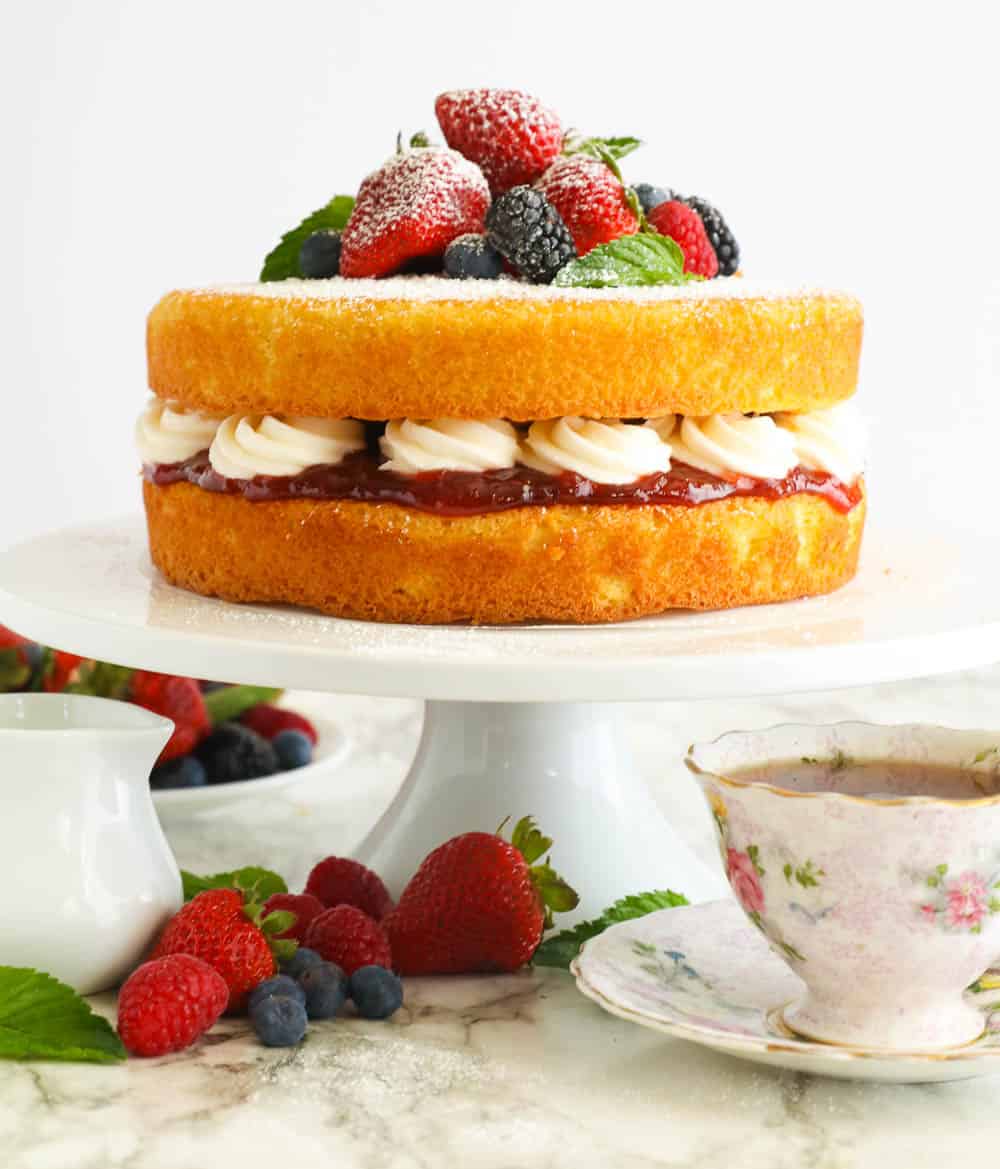
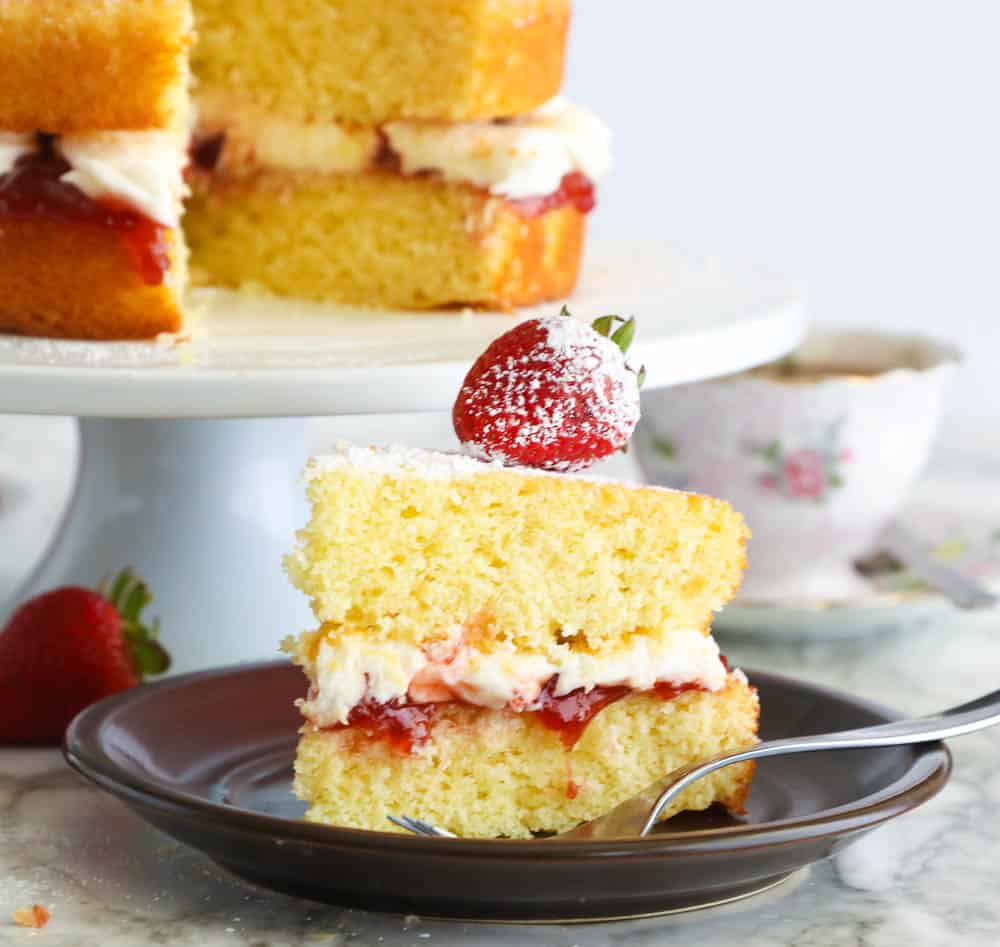
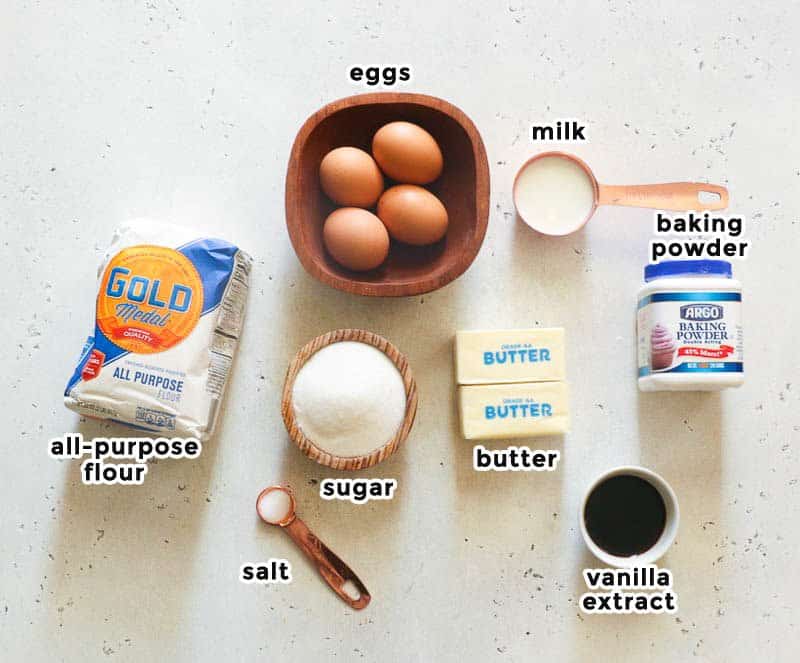
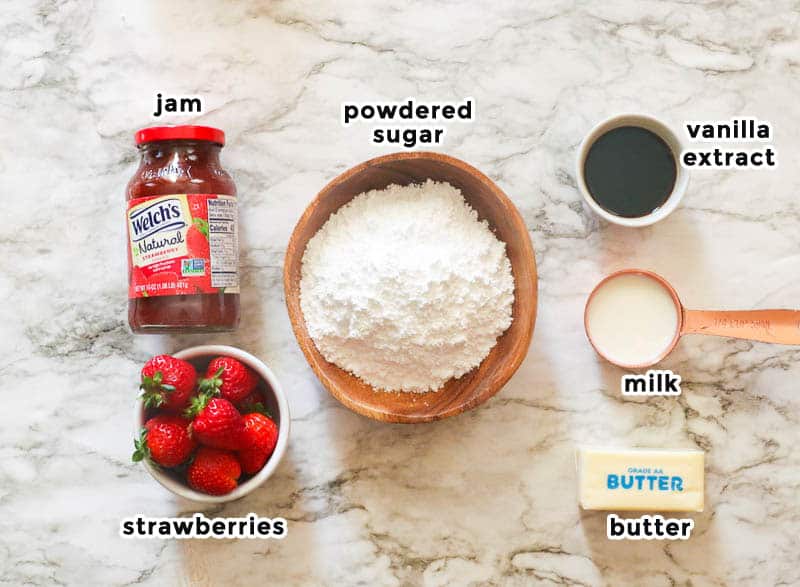
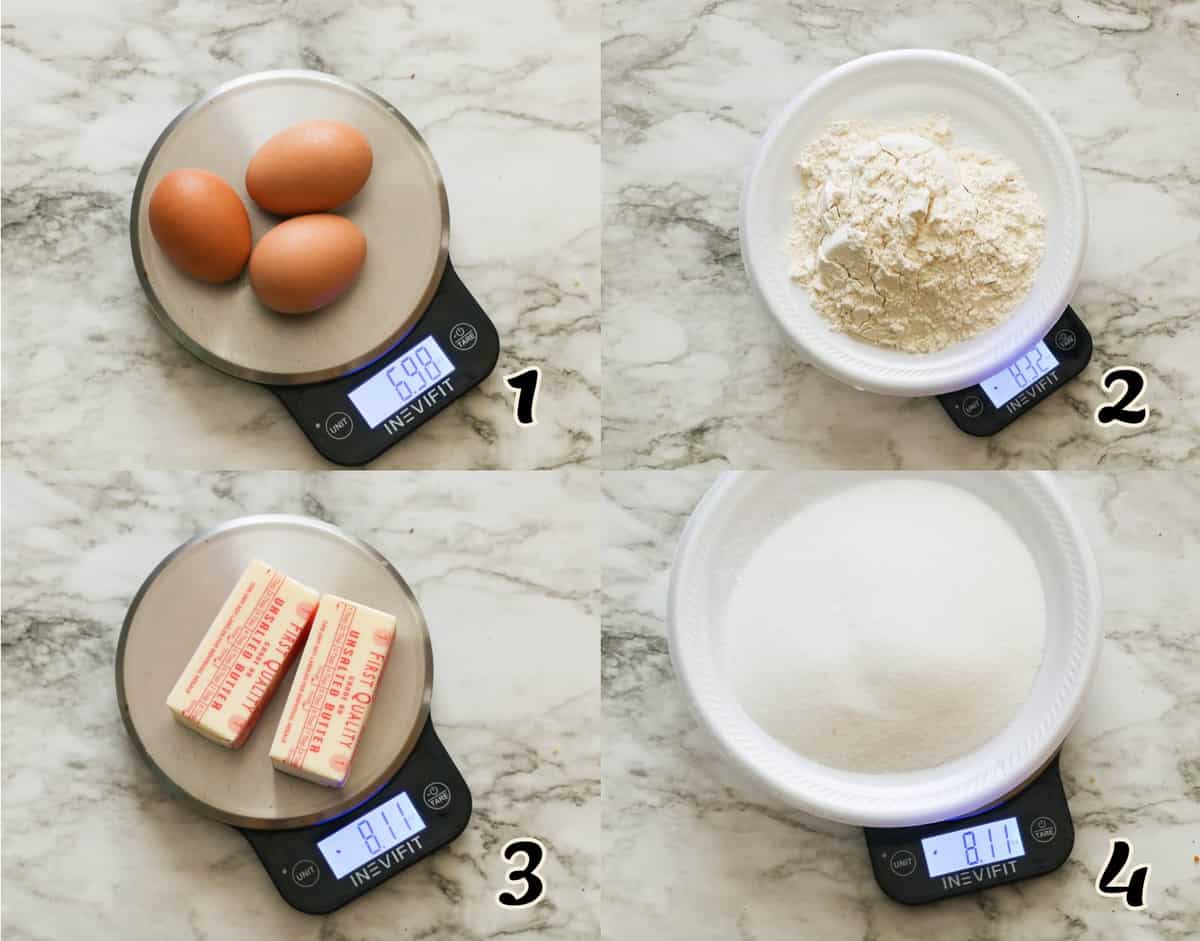
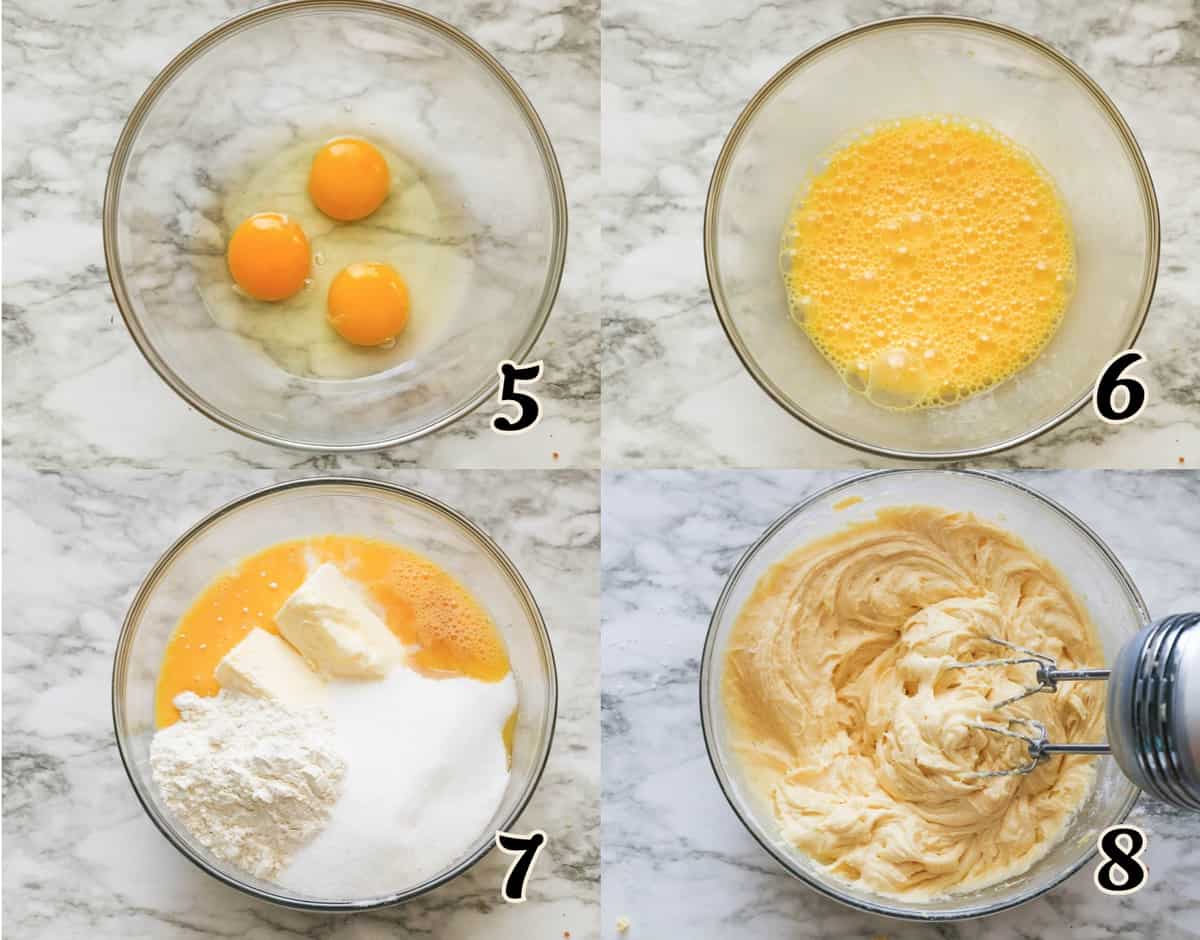
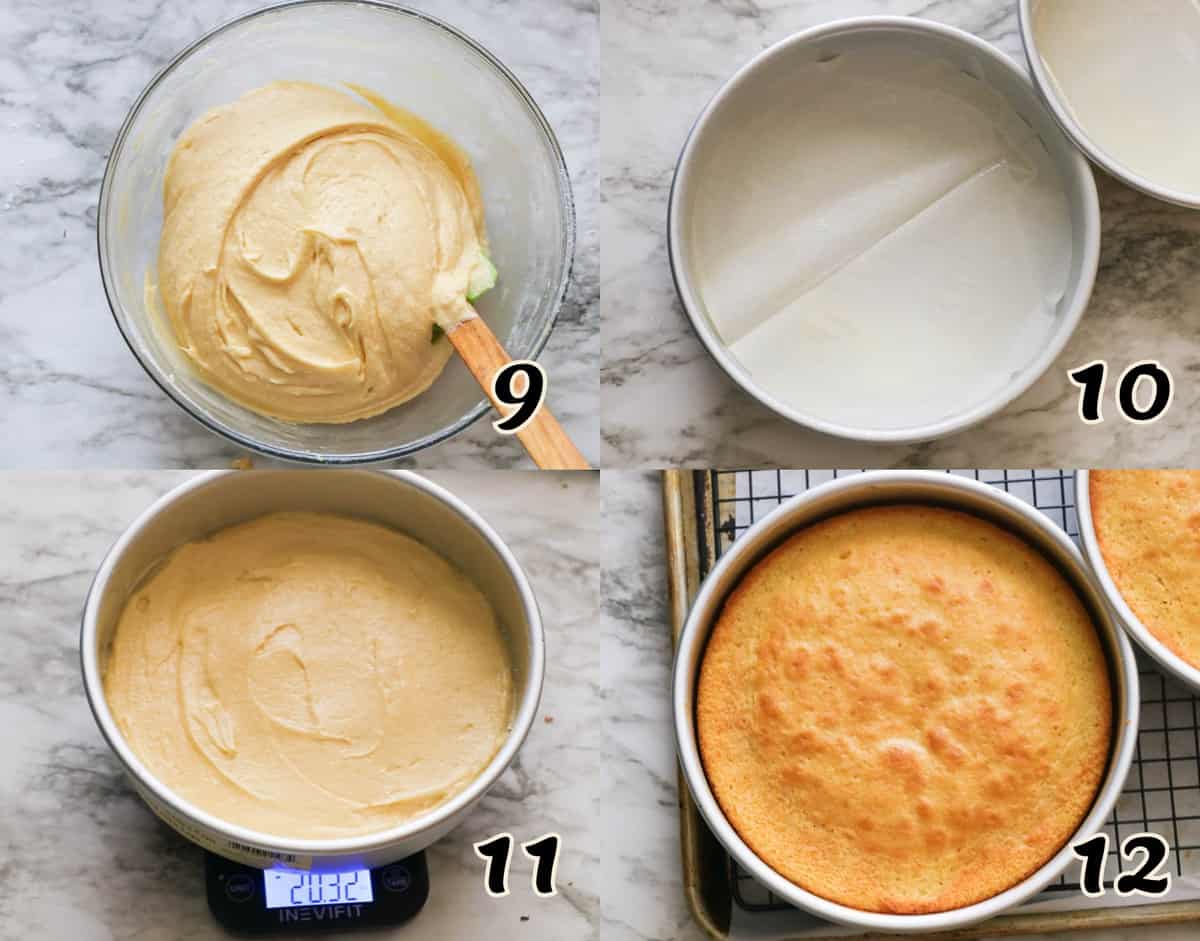
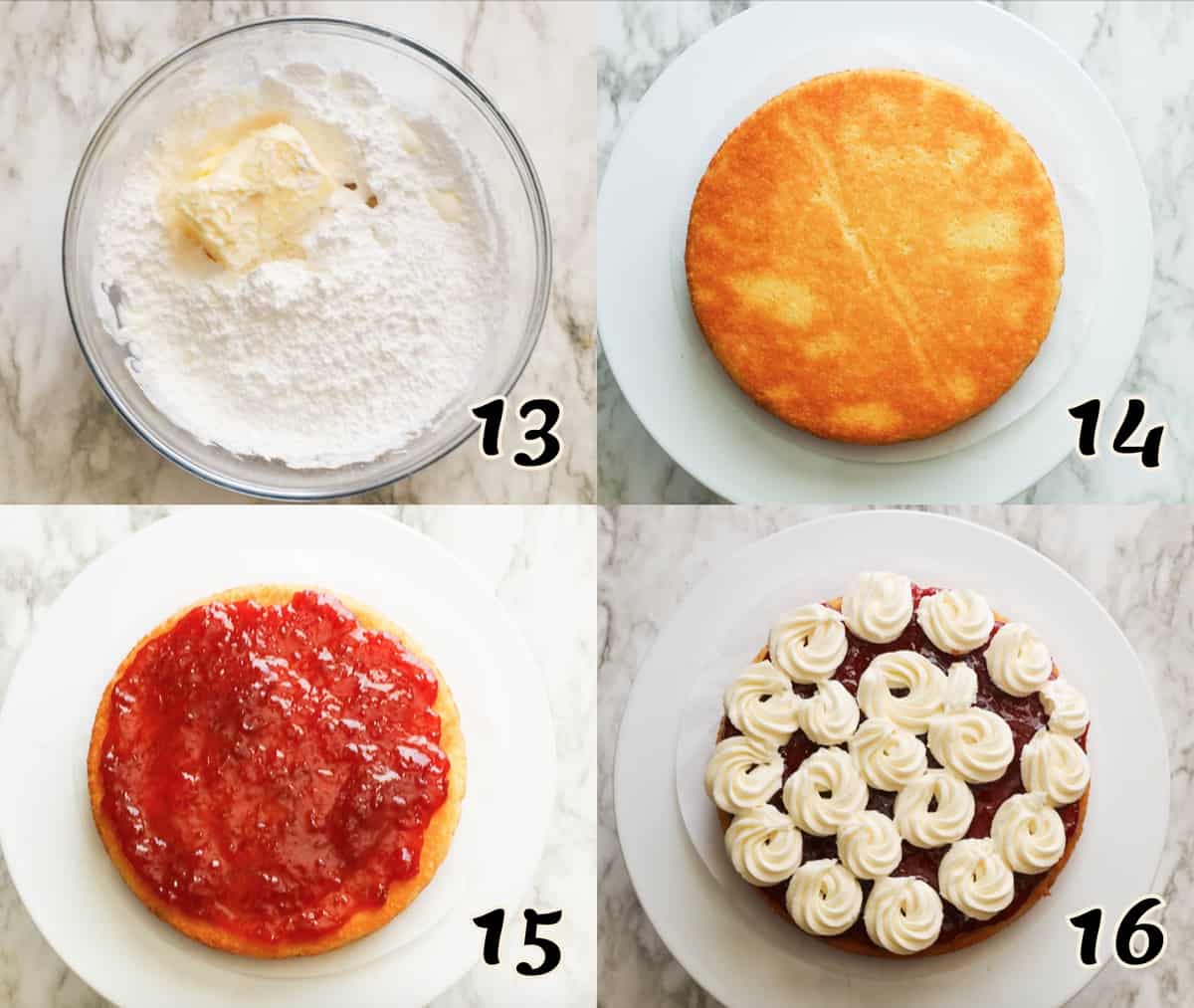
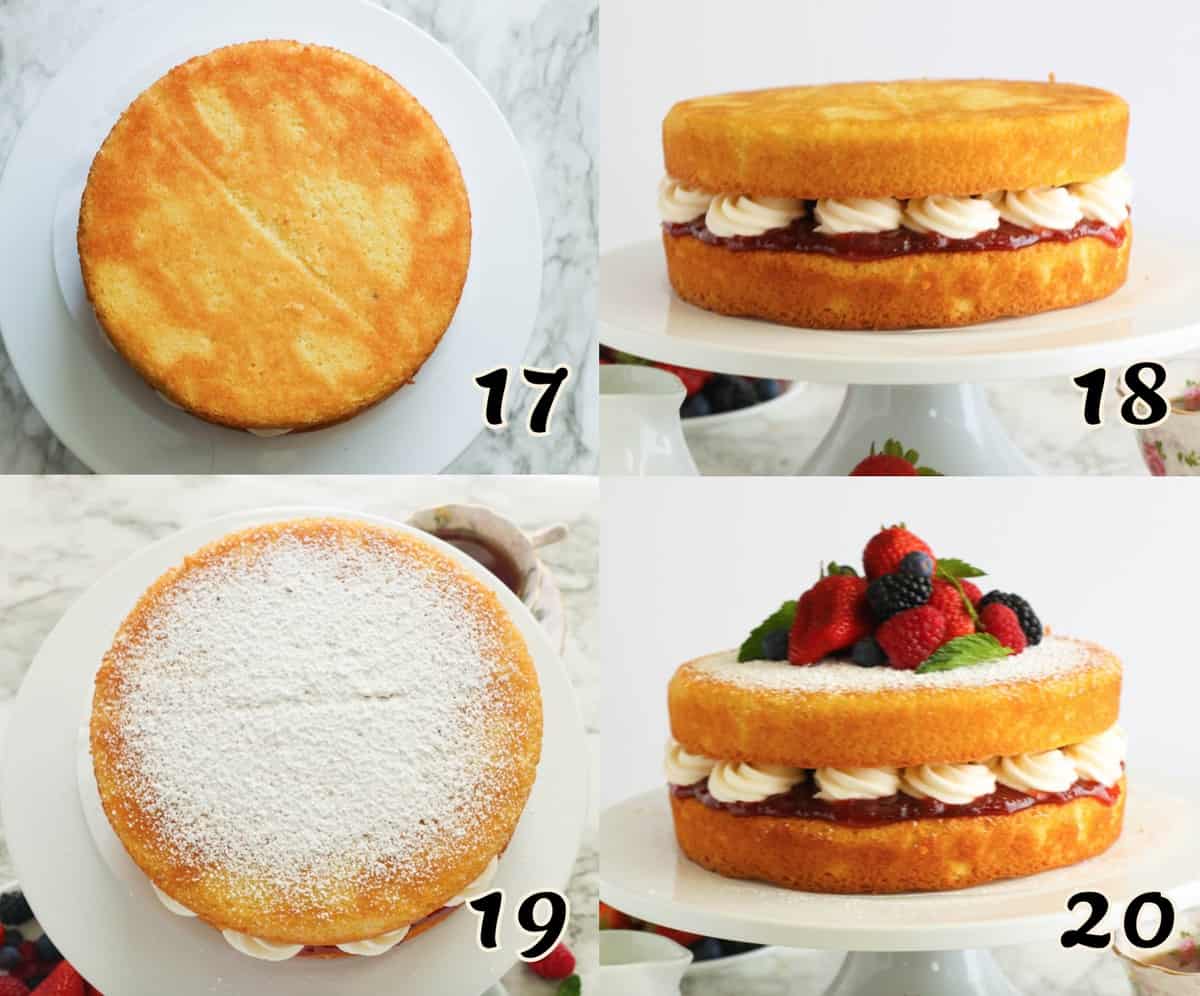

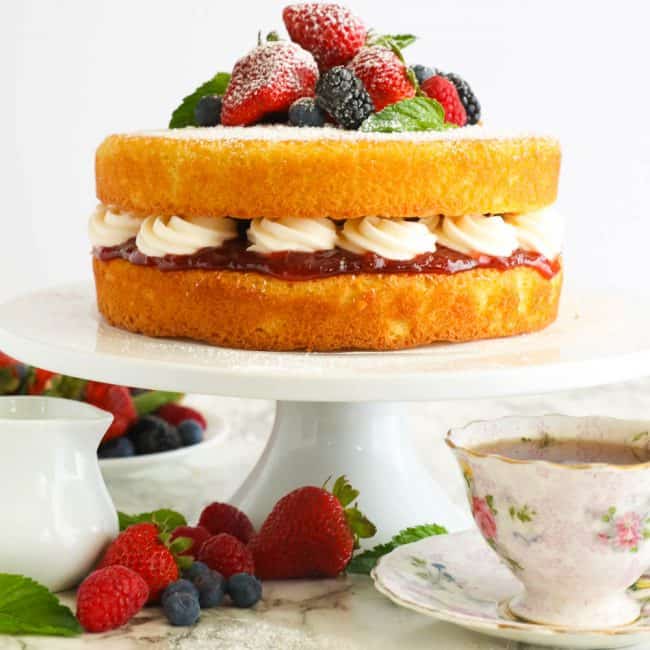
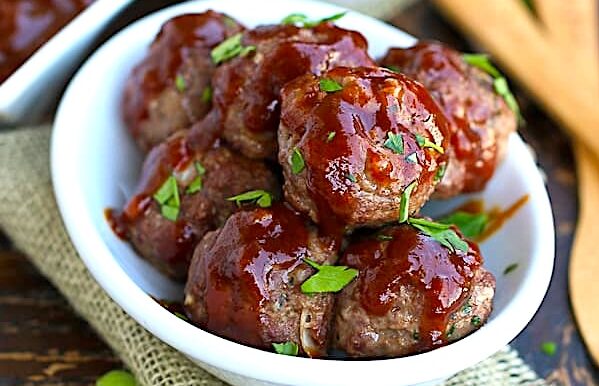
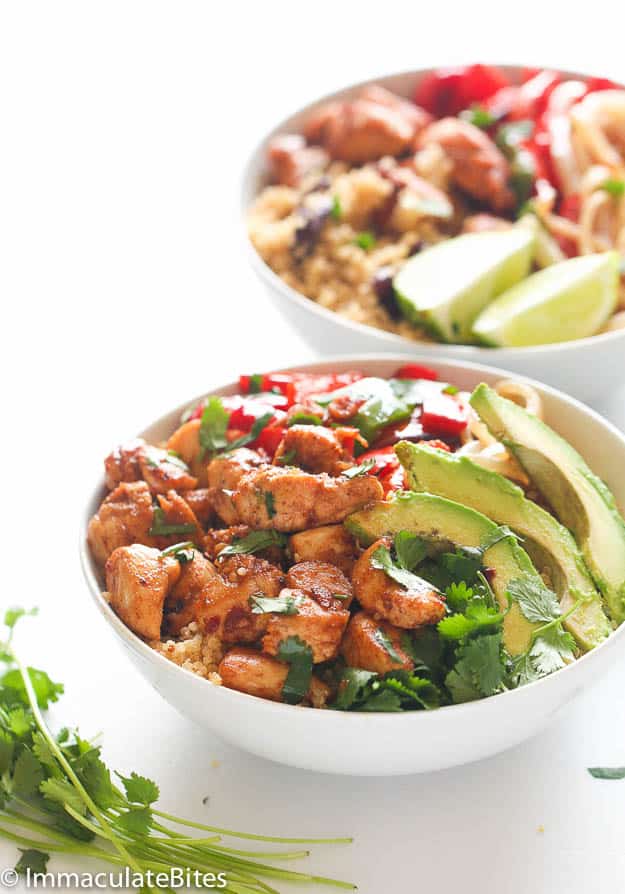
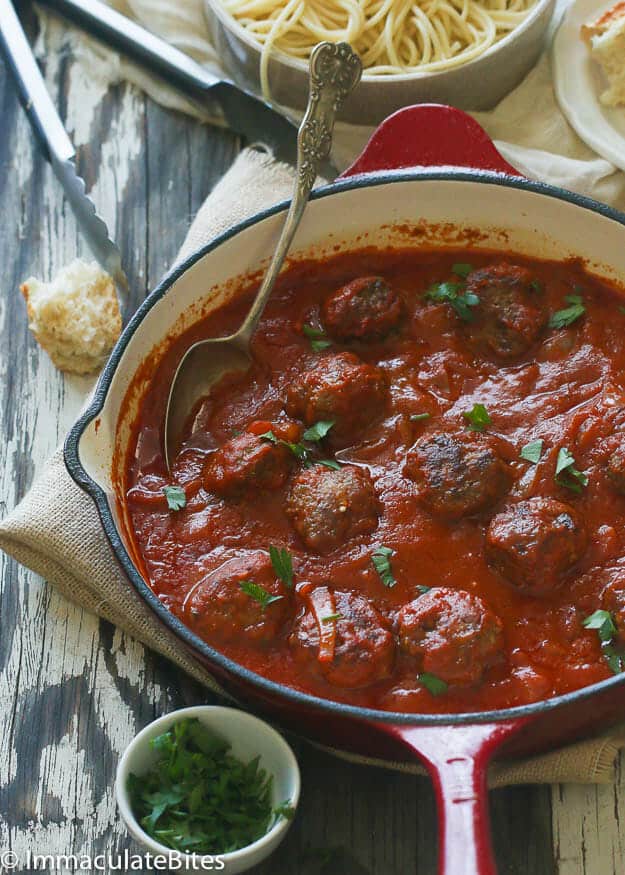
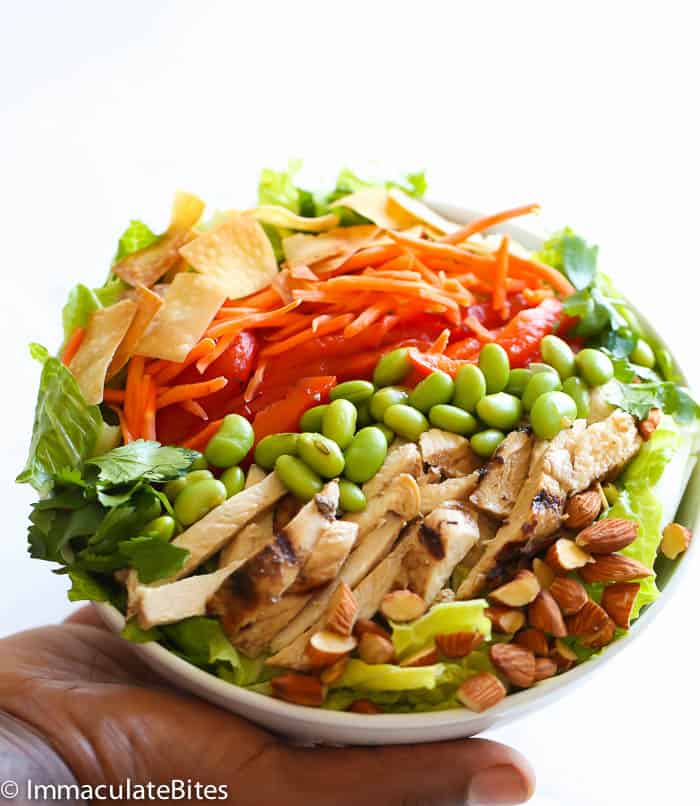
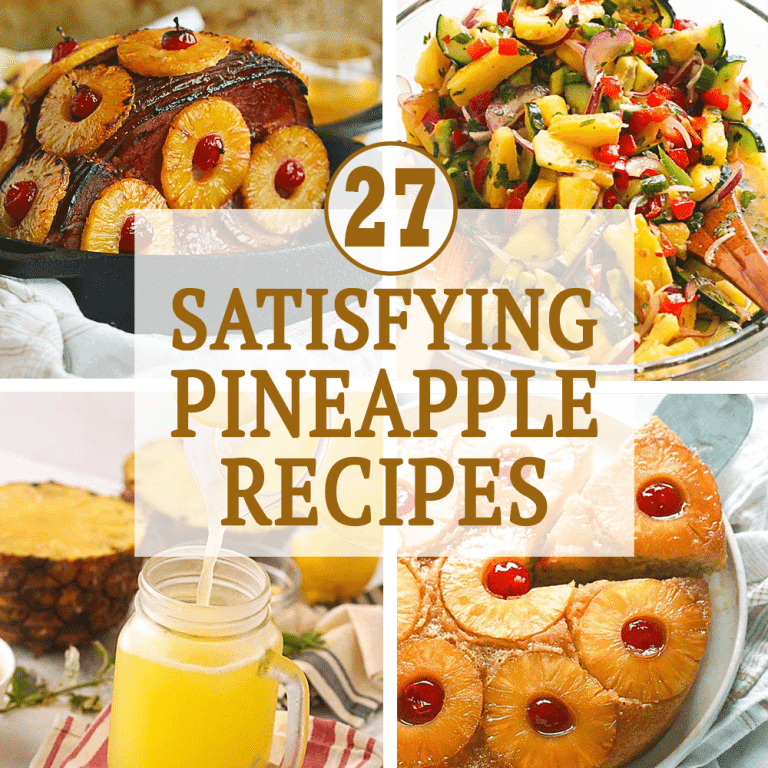
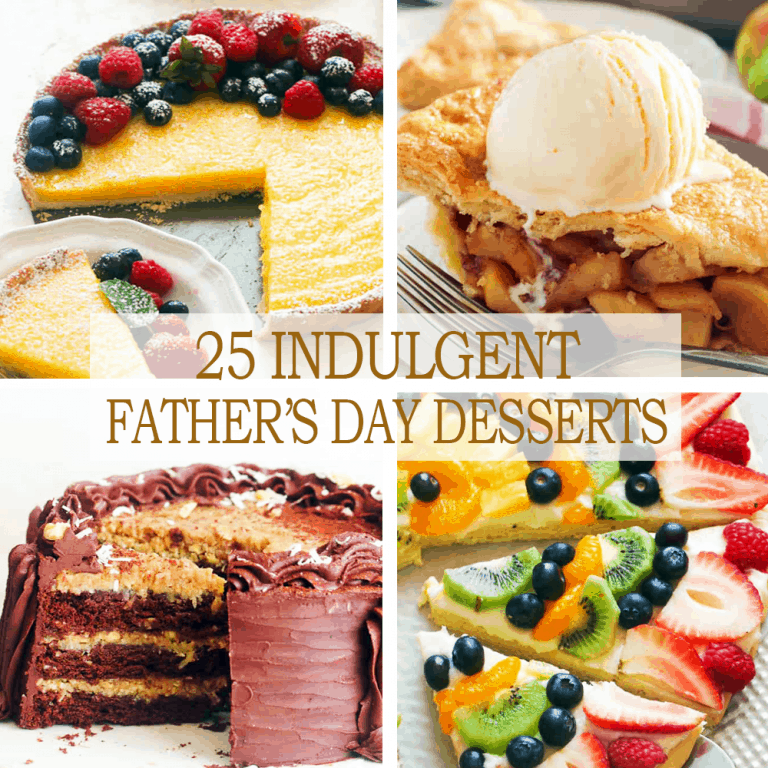
Hi! The recipe mentions using the right pan but what is the right pan? Is it a 10″ or 8″ pan?
Hi, Xia. I used 8″,9″, and 10″ pans and they turn out fine. If you want height, I’d say go for 8″ cake pans.
I’ve never heard of soaking a Victoria sponge in Earl Gray tea which many people find unpleasant to drink. Certainly when I was training in College it was never mentioned and I’ve yet to find that recommendation in any recipe. I’m wondering if you meant to accompany eating it by drinking that tea.
Hi, Julia. Soak here means to brush the cake with Earl Gray tea and let it soak in. 🙂 And yes, this also pairs well with a cup of tea.